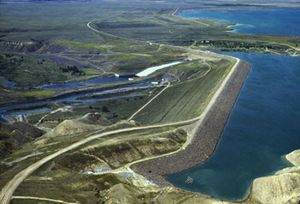Tiber Dam facts for kids
Quick facts for kids Tiber Dam |
|
|---|---|
 |
|
|
Location of Tiber Dam in Montana
|
|
| Country | United States |
| Location | Chester, Montana |
| Coordinates | 48°19′19″N 111°05′52″W / 48.32194°N 111.09778°W |
| Status | Operational |
| Construction began | 1952 |
| Opening date | 1956 |
| Owner(s) | U.S. Bureau of Reclamation |
| Dam and spillways | |
| Type of dam | Embankment, zoned earth-fill |
| Height | 211 ft (64 m) |
| Length | 4,300 ft (1,311 m) |
| Elevation at crest | 3,026 ft (922 m) |
| Width (crest) | 30 ft (9 m) |
| Width (base) | 2,500 ft (762 m) |
| Dam volume | 9,800,000 cu yd (7,492,638 m3) |
| Spillway capacity | Main: 68,467 cu ft/s (1,939 m3/s) Auxiliary: 5,845 cu ft/s (166 m3/s) |
| Reservoir | |
| Total capacity | 1,515,000 acre⋅ft (1.868724984×109 m3) |
| Catchment area | 4,375 sq mi (11,331 km2) |
| Normal elevation | 2,933 ft (894 m) |
The Tiber Dam is a large dam located in Liberty County, Montana. It was built across the Marias River. This dam helps create a big lake called Lake Elwell, which is also known as Tiber Reservoir. The Tiber Dam is considered one of the biggest earth-fill dams in the world. Another famous earth-fill dam is the Fort Peck Dam.
Contents
Building the Tiber Dam
Construction on the Tiber Dam started in 1952. It took about four years to build. The dam was finished and opened in 1956.
Fixing and Improving the Dam
After the dam was built, some parts needed work. Between 1967 and 1969, a special wall called a dike was added. This dike was placed near the dam on the southern side of the lake. It was needed because of issues with the spillway, which is a channel for water to flow over or around the dam.
Later, from 1976 to 1989, the spillway itself was repaired and updated. This made sure the dam could continue to work safely and properly for many years.
How the Tiber Dam Works
The Tiber Dam is an earth-fill dam. This means it is made mostly from compacted earth and rock. It is very long and tall.
- The dam is about 4,300 ft (1,311 m) long. That's more than 13 football fields!
- It stands about 211 ft (64 m) high. This is taller than a 20-story building.
The dike, which was added later, is also quite large. It is 17,000 ft (5,182 m) long and 60 ft (18 m) tall.
Managing Water Flow
Dams need ways to release water safely, especially during heavy rains. The Tiber Dam has a main spillway and an auxiliary (extra) spillway.
- The main spillway has three gates that control the water. It can release a very large amount of water, up to 68,467 cu ft/s (1,939 m3/s).
- The auxiliary spillway can release up to 5,845 cu ft/s (166 m3/s).
- There are also "outlet works" which can release 1,605 cu ft/s (45 m3/s) of water. These different ways to release water help manage the lake level and prevent flooding.


